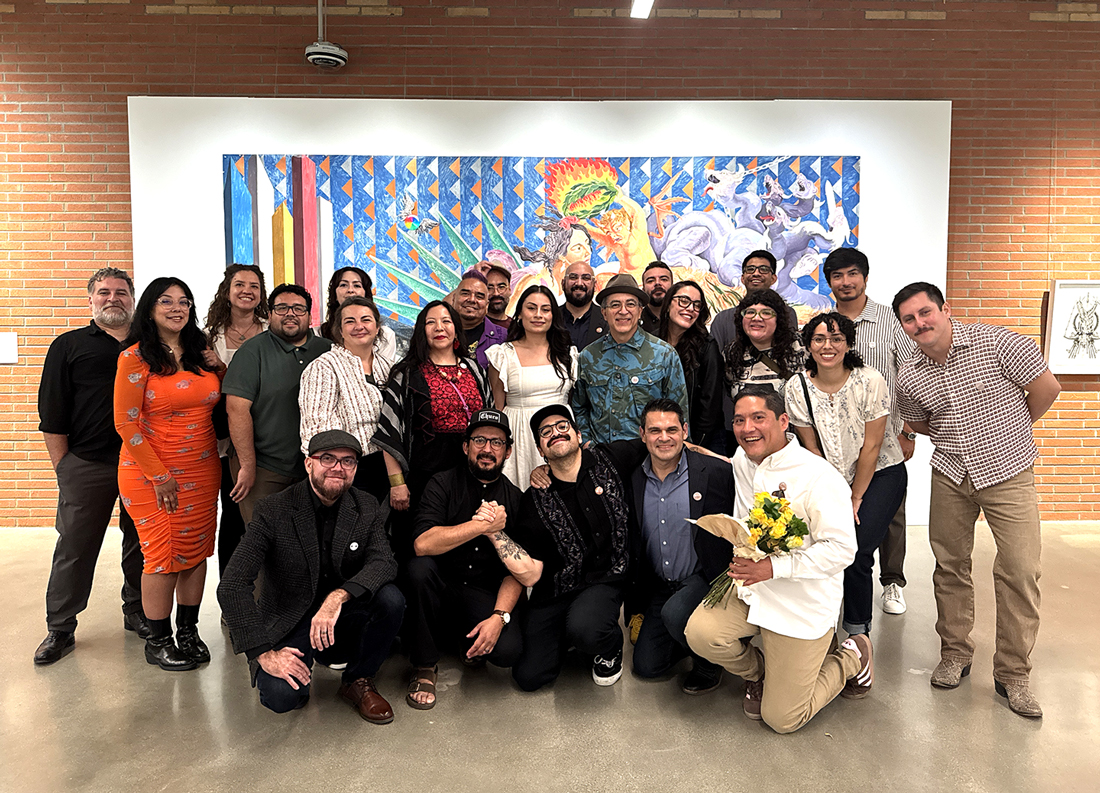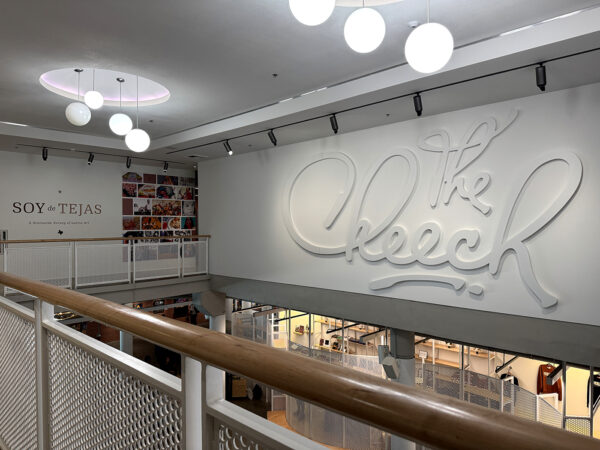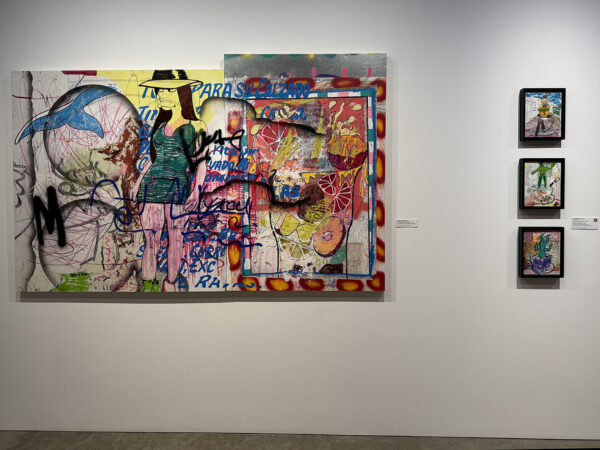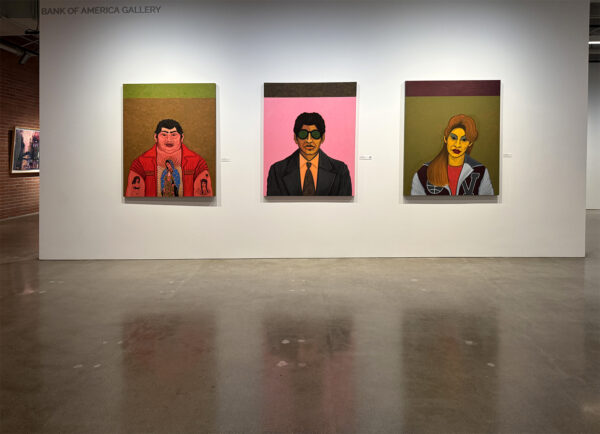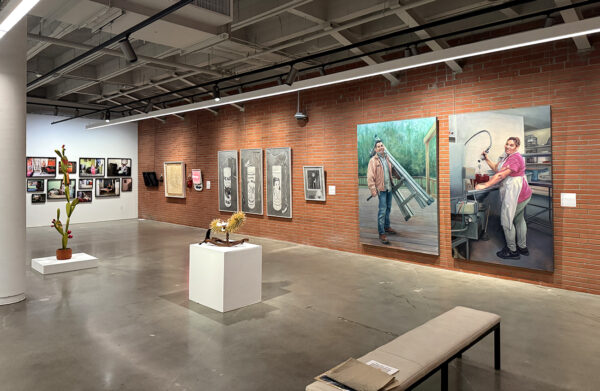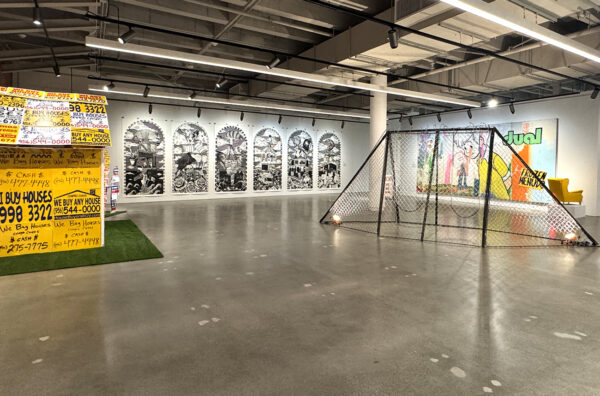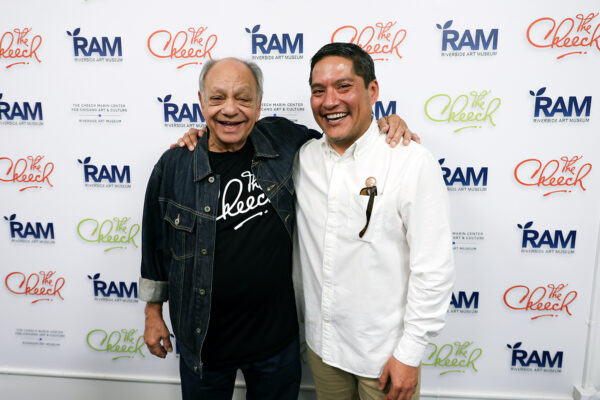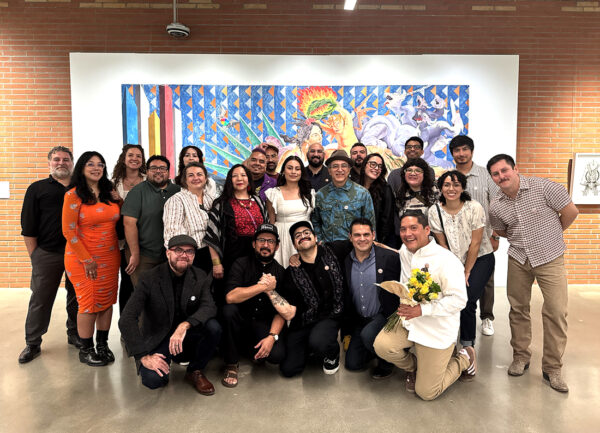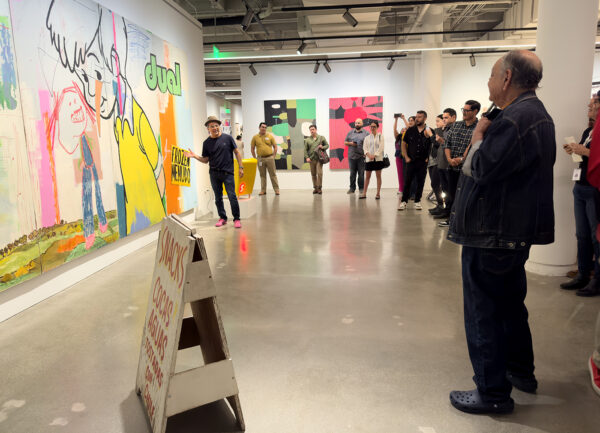What more can I say about Soy de Tejas: A Statewide Survey of Latinx Art? In 2023 I wrote about the first exhibition at Centro de Artes in San Antonio as well as the performances that were part of that iteration, and, in 2024, I reviewed the show when it was on view at Arts Fort Worth. When Soy de Tejas, curated by Rigoberto Luna, debuted in San Antonio it connected Latinx artists across the state in a way that had never been done before. In Fort Worth, the exhibition featured new works by many of the same artists, and brought creatives and audiences from the Valley, San Antonio, Houston, and beyond to North Texas. Earlier this month, a third edition of Soy de Tejas opened at The Cheech Marin Center for Chicano Art & Culture in Riverside, California.
“Soy de Tejas: A Statewide Survey of Latinx Art” at The Cheech Marin Center for Chicano Art & Culture in Riverside, California
During the opening weekend, I ruminated on what it means to bring a show of Texas artists to California. Of course, that answer is relatively simple: it is significant to showcase Texas Latinx artists outside of the state, on a national stage, particularly when they have been (maybe unintentionally) omitted from larger conversations about Latinx and Chicano art.
Luna echoed my thoughts on the matter. He told me: “Too often, the art world’s attention gravitates toward New York or California, leaving Texas artists overlooked. We wanted to change that and make our presence known. Bringing the exhibition from community galleries in Texas to a museum in California, especially The Cheech, not only validates the project’s success but also expands its reach.”
And that part, “especially The Cheech,” reverberated throughout the opening events. Even before I boarded the plane, the fact that I was going to meet and speak with Cheech Marin was a huge point of interest for my family, who generally do not follow the art world. Museums, galleries, artists, the whole thing is a foreign concept to my folks; but Cheech Marin means something to them. This sentiment was shared by some of the show’s artists, including Dallas-based Tina Medina and Karla Garcia.
Works by Tina Medina on view in “Soy de Tejas: A Statewide Survey of Latinx Art” at The Cheech
Medina explained that her father, a Mexican American who was born and raised in South Texas in the 1950s, had few role models in the media. “Cheech Marin came onto the scene during the ‘70s, when my dad was a young man… My dad was a warm and funny guy. He loved to make jokes. Joking was a way for our little family to get through the tough parts of life. Cheech was always an important part of our lives because he represents us and because he made us laugh. He made my Dad laugh. We definitely identified with Cheech’s humor; he got us, he was us!”
Medina shared that she and her siblings found a sense of belonging in the U.S. through the performances of Latinos on television. “We felt that if Selena, or Cheech, or someone like that could make it in the U. S., maybe we could too,” she explained. Though her father died in 2019, a photograph of him at the age of 5, incorporated into Medina’s work, is on view at The Cheech now. She added, “His presence was felt as I gave interviews, had videos and photos taken, and even as I spoke with Cheech about my art. Cheech’s support of Latinx artists is incredibly important especially now and I am so honored to have been included in this exhibition. I can feel that Dad is proud and saying, ‘¡Te aventaste Tina!’”
For other artists in Soy de Tejas, while being at The Cheech was significant, it wasn’t a first. Both Cande Aguilar and Joe Peña have work in Marin’s collection, and a few paintings by Aguilar are on view in the museum’s exhibition Cheech Collects IV.
Works by Joe Peña on view in “Soy de Tejas: A Statewide Survey of Latinx Art” at The Cheech
Peña’s work was first collected by Marin in 2012, after the comedian-turned-art-collector saw the artist’s work in a small Corpus Christi gallery. Peña told me, “At that time I was making small paintings about foods of our culture — lengua, tripas, etc. — which weren’t selling too well, but I didn’t care, I was just enjoying painting them.” He noted that it was incredibly validating to have his work collected by Cheech, not just due to his reputation but also because the collector understood the work on a deeply personal level. Peña noted that when Cheech unboxed the purchased paintings, he said, “Ah lengua…it reminds me of backyard parties and dinner with family.”
Works by Cande Aguilar in “Cheech Collects IV” at The Cheech
Aguilar reflected on the first time Marin collected his work in 2018. The two met at K Space Studios in Corpus Christi. “He handed me a one-hitter, and I handed him a barrioPOP book. Two months later…he acquired Las Varatas (2008). At the time, I had no idea he was on his way to establishing what would become his namesake museum. Still, I knew the moment was significant. His collection carried both legitimacy and breadth, and that acquisition marked an unexpected shift in my journey as a visual artist. It was the moment my contribution of barrioPOP to the art world, particularly the Chicano art world, became solidified.”
About 30% of Marin’s collection, which includes over 100 artists, is made up of Texans. He told me that in the early days of building his collection he was introduced to Texas artists through Sofia (Sonia) Pérez Parks, who at the time had a gallery in San Antonio and Los Angeles. Marin explained that one of the goals of his collection is to showcase the breadth of Chicano artists, and in doing so illustrate that they are living and working outside of Los Angeles, in places like Chicago, Kansas City, across Texas, and in large cities and small towns throughout the U.S.
Works by César A. Martínez on view in “Cheech Collects IV” at The Cheech
Other Texas artists in Cheech Collects IV include Carlos Donjuan, Adan Hernández, Benito Huerta, César A. Martínez, Jimmy Peña, Ricardo Ruiz, and Vincent Valdez. Showcased alongside other significant Chicano figures, such as Judithe Hernandez, Wayne Alaniz Healy, and Frank Romero, the Texas artists’ works simultaneously connect with larger themes and add a distinct texture to the collection.
A painting by Carlos Donjuan on view in “Cheech Collects IV” at The Cheech
“Soy de Tejas: A Statewide Survey of Latinx Art” at The Cheech
Upstairs, this iteration of Soy de Tejas is closer to the original San Antonio exhibition with many of the same artworks on view. And while the two-story building of Centro de Artes was a beautiful home for the show, the artwork truly sings at The Cheech. A video work by Natalia Rocafuerte and an installation by Stephanie Concepcion Ramirez were given a dedicated darkened room, allowing for a more meaningful viewing of the pieces than had been possible in other venues. Pieces by Ruben Luna, Ingrid Leyva, Arely Morales, Marianna Olague, Juan de Dios Mora, and Josué Ramirez reverberated off of the exposed brick walls. Other architectural elements, like pillars and special buildouts, showcased textile works by Sarah Zapata and Francisco Moreno’s massive painting on paper.
“Soy de Tejas: A Statewide Survey of Latinx Art” at The Cheech
The Cheech feels like the perfect home for a show with several large-scale pieces — Ben Muñoz’s prints, Angel Cabrales’ Juegos Fronteras: Swingset Penitentiary sculpture, Violette Bule’s installation with mirrors that spell out, “CAN YOU?” It was a reminder that, though the midsized venues that provided a platform for Soy de Tejas were important for many reasons, this show, these works, belong in a museum. As a Texan, I am excited that new audiences will be exposed to the variety of artists hailing from our state. Whether created through painting, drawing, printmaking, photography, video, sculpture, textiles, or mixed media, the works in Soy de Tejas speak to personal, regional, and universal cultural touchpoints.
When talking about future plans, Marin mentioned his interest in creating a low rider museum. He spoke about low riders as “a true Chicano art form that is international.” He went on to explain that through his collection and museum he hopes to demonstrate that, “You don’t have to be Chicano to love Chicano art, or appreciate it, anyways.” He added, “I’m not French, but I know a lot about Impressionists… or Expressionists, not German, you know…But essential qualities of art, you recognize it in every culture when you open your eyes or are educated to do that.”
Cheech Marin and Rigoberto Luna. Photo courtesy of The Cheech Marin Center for Chicano Art & Culture
Reflecting on Soy de Tejas at The Cheech, Peña told me, “I see a remarkable similarity in what Cheech Marin and Rigoberto Luna are trying to accomplish. Rigo has been influential in bringing further attention to that of Texas Chicano artists and Cheech has been influential in doing the same but with a wider reach…Soy de Tejas at The Cheech accomplishes a shared vision and goal of both Cheech and Rigo, that of exposing the work of Chicano artists to a broader audience.”
When asked about his goals for this iteration of the show, and about the potential for future venues, Luna said, “Honestly, I don’t have set expectations for this presentation, Soy de Tejas has consistently exceeded anything I could have imagined. It feels like a project that keeps giving, not just to me personally but to the artists involved as well. What excites me most is the chance to bring all these artists and personalities back together. With each iteration, our relationships deepen, and that sense of community has been one of the most rewarding aspects of the project.”
“Soy de Tejas” artists with curator Rigoberto Luna at The Cheech
That camaraderie was on full display during the opening weekend at The Cheech. Of the 38 artists in the show, 25 made their way to Riverside for the reception. After the event, the group gathered for dinner and drinks and a celebratory night of catching up, playful jabs, and uplifting each other. In the morning the artists gathered at the museum, before it opened to the public, for a walkthrough of the show with Marin. In the gallery, each artist spoke directly with Cheech, explaining the context of their work. And he was fully engaged, locked in, and genuinely interested to learn about each piece and artist. The experience was full of care and community as the artists documented each other’s moment with Marin and applauded at the end of each short talk. After, Marin met privately with the artists in the museum’s offices.
Cande Aguilar speaks with Cheech Marin and a group of artists in the “Soy de Tejas” exhibition at The Cheech
I wished I could have stuck around to observe visitors’ reactions and feedback to the show, but, after a quick two days, it was time to head back to Texas. As a final thought, Luna shared, “Bringing the exhibition to Riverside, which is home to a large Latino community, feels especially meaningful. I hope audiences here find the work as inspiring and transformative as it has been in Texas, and that it resonates viscerally, instilling pride in our shared histories that extend beyond borders.”
Soy de Tejas: A Statewide Survey of Latinx Art is on view through January 11, 2026, at The Cheech Marin Center for Chicano Art & Culture in Riverside, California.

